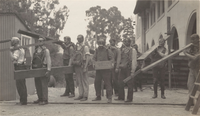
The Lawson Adit is a horizontal mine tunnel, or adit, on the UC Berkeley campus, near the Hearst Mining Building, dug directly through the Hayward Fault.[1] Started in 1916, the adit is named after Andrew Lawson, one-time Dean of the College of Mining at UC Berkeley.[2]
History
The adit was dug under the direction of Frank H. Probert, who had just previously been appointed Professor of Mining.[3] It was dug primarily for instructional purposes, with secondary hopes that it would represent a new source of water for the campus.[1][4] Much of the equipment to dig and use the tunnel was donated by the mining industry in the San Francisco Bay area.[4] Although an initial report said that it was to go 1,800 feet into the Berkeley Hills,[3] the actual construction resulted in a mine tunnel of about 200 feet.

Between 1919 and 1930 the adit was used to give mining and metallurgy students hands-on training, specifically to provide "sound, practical training in drilling, drifting, blasting, timbering, and mine surveying."[1][4] This training included instruction in the use of dynamite as well as the extraction of precious metals[1] and practice and demonstration of rescuing techniques.[5]
In 1935, Berkeley engineering students celebrated the annual March 15 Engineers' Day by putting together "a museum of historical electrical equipment," holding a dance at the Hotel Claremont, and engaging in a "mine rescue" in the Lawson Adit next to the Hearst Memorial Mining Building.[6]
Around 1939 the adit was extended to around 900 feet so that it intersected the Hayward Fault and could be used for a direct study of the fault[1] by George Louderback, a seismologist at UC Berkeley, to help determine the safety of building a new women's dormitory, Stern Hall. Louderback's studies in the adit revealed that the Hayward Fault at this point is surrounded by a particularly unstable mélange of serpentine and other metamorphic rocks.[7] He suggested that Stern Hall be built approximately fifty feet away from its original planned location.[1][4]
After 1939, much of the extended adit eventually collapsed, with most collapses around the point where the adit intersects the fault. Today the adit is only maintained to a length of about 260 feet,[1][4] and is not in use due to safety reasons.[8]
References
- ^ a b c d e f g "The lore of Lawson Adit". Berkeleyan. 19 September 2002. Retrieved 5 November 2011.
- ^ University. Regents, University of California (System). Office of the President, University of California (1916). Report of the President of the University on behalf of the Regents.
- ^ a b "Editorial Correspondence, Oct. 20". Engineering and Mining Journal. American Institution of Mining Engineers. 102: 805. 1916.
- ^ a b c d e Helfand, Harvey (2002). University of California, Berkeley : an architectural tour and photographs (1st ed.). New York: Princeton Architectural Press. ISBN 978-1-56898-293-9.
- ^ "Unique Parade is Engineer's Opener". Berkeley Daily Gazette. 14 March 1924.
- ^ Steven Finacom (March 11, 2010). "Berkeley history: UC Berkeley sought support in 1935". My Town. Tri-Valley Herald. Archived from the original on January 16, 2013. Retrieved October 20, 2012.
- ^ Curtis, Garniss H (16 October 2008). "Emeritus Professor of Geology Weighs In on Memorial Stadium". Berkeley Daily Planet. Retrieved 5 November 2011.
- ^ "Hearst Mining Building". Berkeley Seismological Laboratory. October 24, 2000. Archived from the original on May 8, 2014. Retrieved 2012-10-20.
External links
37°52′30″N 122°15′24″W / 37.87494°N 122.256673°W
